新概念二册课件Lesson42 Not very musical(共28张PPT)
文档属性
| 名称 | 新概念二册课件Lesson42 Not very musical(共28张PPT) |  | |
| 格式 | pptx | ||
| 文件大小 | 43.7MB | ||
| 资源类型 | 教案 | ||
| 版本资源 | 新概念英语 | ||
| 科目 | 英语 | ||
| 更新时间 | 2021-03-19 15:05:26 | ||
图片预览



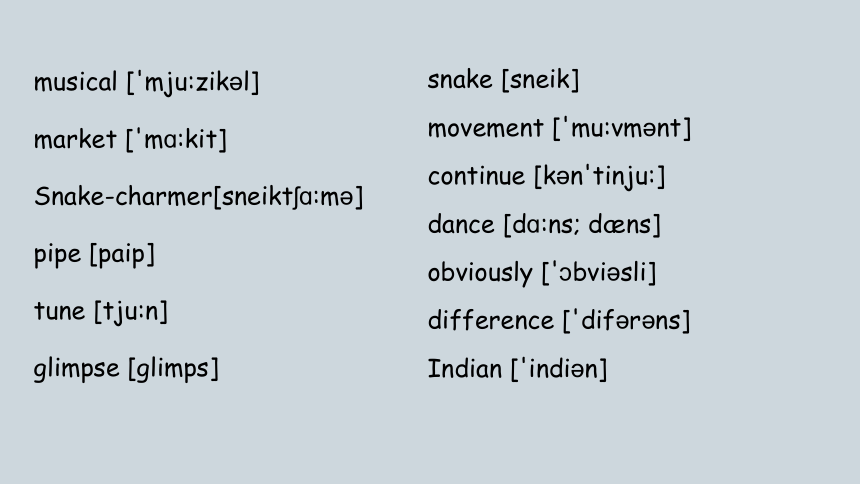
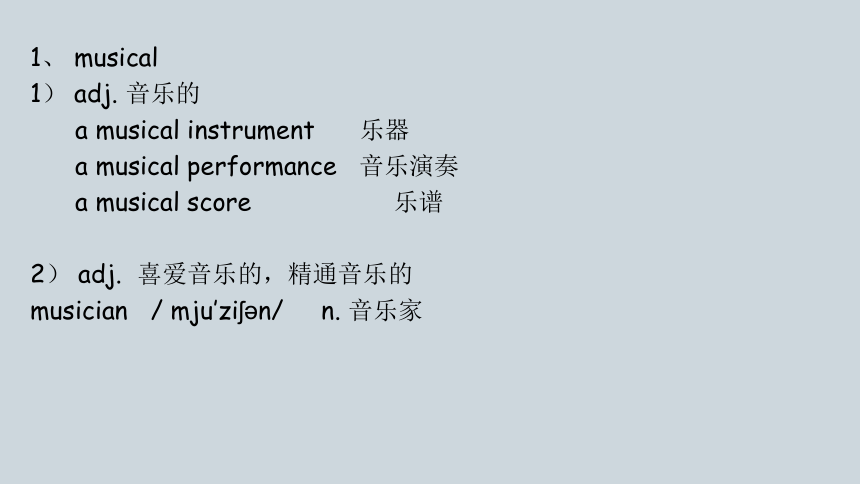
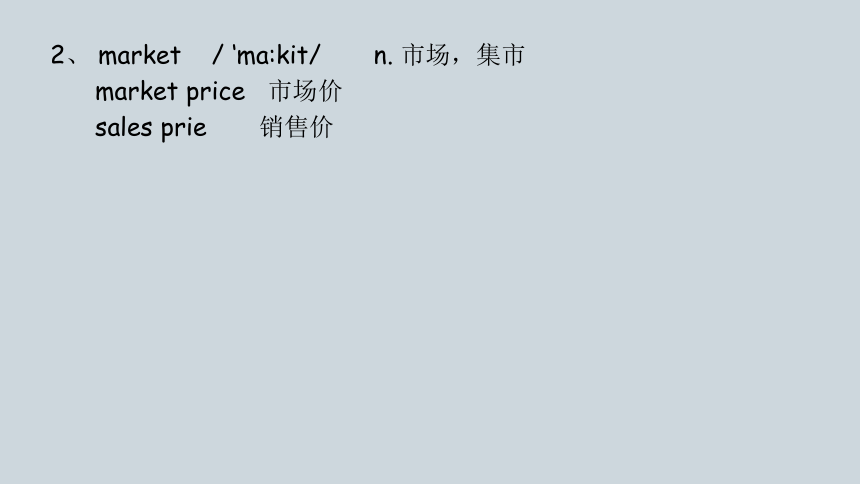
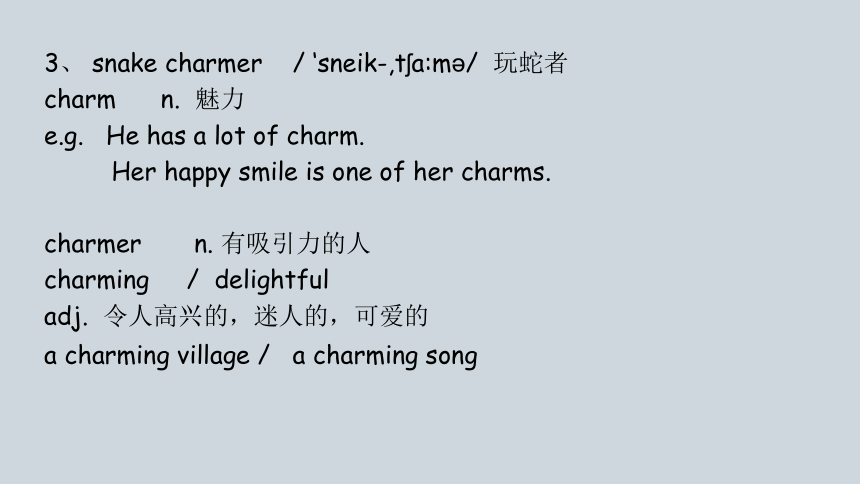

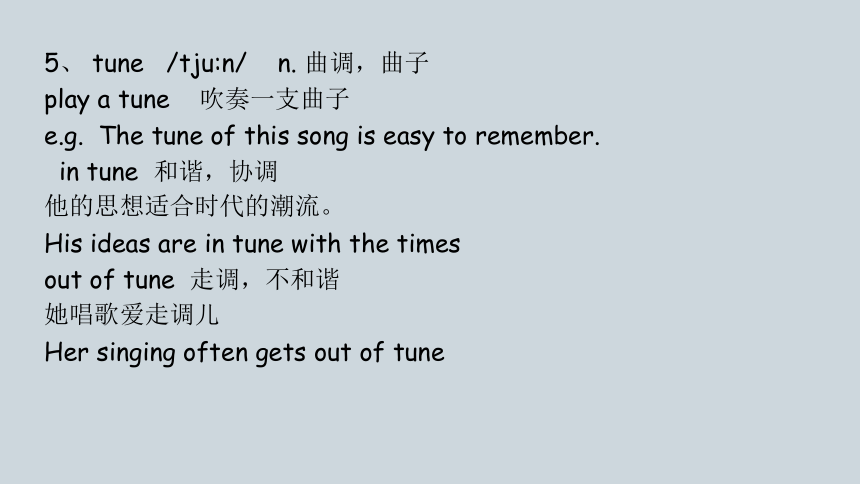
文档简介
Not very musical
42
Daily proverb
The weakest link in a chain is the strongest because it can break it.
在一个链条里,最弱的一环也可能是最强的,因为它可以使整个链条断掉。
NO.1
New Words
musical ['mju:zik?l]
market ['mɑ:kit]
Snake-charmer[sneikt?ɑ:m?]
pipe [paip]
tune [tju:n]
glimpse [glimps]
snake [sneik]
movement ['mu:vm?nt]
continue [k?n'tinju:]
dance [dɑ:ns; d?ns]
obviously ['?bvi?sli]
difference ['dif?r?ns]
Indian ['indi?n]
1、 musical
1) adj. 音乐的
a musical instrument 乐器
a musical performance 音乐演奏
a musical score 乐谱
2) adj. 喜爱音乐的,精通音乐的
musician / mju’zi??n/ n. 音乐家
2、 market / ‘ma:kit/ n. 市场,集市
market price 市场价
sales prie 销售价
3、 snake charmer / ‘sneik-,t?a:m?/ 玩蛇者
charm n. 魅力
e.g. He has a lot of charm.
Her happy smile is one of her charms.
charmer n. 有吸引力的人
charming / delightful
adj. 令人高兴的,迷人的,可爱的
a charming village / a charming song
4、pipe / paip / n. (吹奏的)管乐器
1) 管子 (tube )
a water-pipe 排水管
a gas-pipe 排气管
2) 管乐器
a bamboo pipe 竹笛
piper 吹笛者
5、 tune /tju:n/ n. 曲调,曲子
play a tune 吹奏一支曲子
e.g. The tune of this song is easy to remember.
in tune 和谐,协调
他的思想适合时代的潮流。
His ideas are in tune with the times
out of tune 走调,不和谐
她唱歌爱走调儿
Her singing often gets out of tune
6、 glimpse / glimps/
n. 一瞥,一看(通常做单数)
看他一眼就够了。
One glimpse on him is enough.
我窥见到他的真实感情。
I had a glimpse of his true feelings
have a glimpse of…瞥见了
catch a glimpse of…一眼瞥见某人或某事物
get a glimpse of…瞥见;窥见
7、movement / ‘mu:vm?nt/ n. 动作
move
1) v. 移动,改变位置
e.g. Don’t move, stay still.
2) 使(某人)感动,使动心
e.g. The story moved us deeply.
moving adj. 令人感动的
moved adj. 感到感动额
8、 continue / k ?n’tinju / v. 继续
continue to do
continue doing sth
go on doing sth.
继续做某事
NO.2
Grammar
一、have + 宾语 + 不定式
该结构中have的基本意思是“有”,其主要用法有:
1. 表示有某事要做,其中的不 定式为定语。
如:
她没有勇气拒绝。
She didn’t have the courage to refuse.
鸟有飞的本能
Birds have the instinct to learn to fly.
我们有充分理由认为他可能还活着。
We have every reason to think he may still be alive.
2. 表示因为有A结果发生了B,其中的不定式为结果状语。
如:
I had the luck to find him at home.
我真幸运,找他时他正在家。
They had the misfortune to be hit by a violent storm. [?m?s?f?:rt?u:n] [?va??l?nt]
他们不幸遇上了猛烈的风暴。
二、have + 宾语 + 动词原形
该结构中的动词原形,实为省略了to的不定式,用作宾语补足语,其中的have为使役动词。该结构的主要用法有:
1. 表示叫(请、使 、让)某人做某事。
如:
He had his son clean the car.
他叫他的儿子擦车。
I’ll have the gardener plant some trees.
我要让园丁种些树。
Don’t interrupt her:let her have her say.
别打断她的话,让她把意见说出来。
2. 表示容忍或允许某人做某事(用于否定句,尤与 won’t, can’t连用)。如:
I won’t have you tell me what to do.
我不能让你对我做的 事指手划脚。
三、have + 宾语 + 现在分词
该结构 中的现在分词用作宾语补足语,其中的have为使役动词。该结构的主要用法有:
1. 表示使(让)某人(某事物)一直做在做某事或处于做某事的状态之中。如:
She had her audience listening attentively.
她使听众听得入神。[??:di?ns] [?'tent?vl?]
The film had us all sitting on the edges of our seats with excitement.[ed?] [?k?sa?tm?nt]
这部影片让我们大家激动不已。
2. 表示容忍或允许某人做某事(用于否定句,尤与 won’t, can’t连用)。如:
He won’t have boys arriving late.
他不允许孩子们迟到。
I won’t have? you smoking at your age.
我不能让你在这个年纪就抽烟。
I hate to have m y boss standing over me.
我不喜欢上司监督我。
3. 说服或命令某人做某事。
He had me doing all kinds of jobs for her.
他叫我为她做各种事情。
注:have difficult? doing sth是英语中一个很有用的句式,其中的have表示“有”,
We had the greatest difficulty imaginable getting here in time. [??m?d??n?bl]
我们为了及时赶到此地,经历了可能想见的最大的困难。
四、have + 宾语 + 过去分词
该结构中的过去分词用作宾语补足语,其中的have为使役动词。该结构的最大特点就是,其中的过去分词与其 前的宾语有被动关系。
1. 表示请(让)别人做某事。
We had the machine repaired.
我们请人修理了机器。
She’s gone into hospita l to have her appendix taken out. [??p?nd?ks]
她已住院去切除阑尾。
What beautiful curls — why do you want to have them cut off ? [k?:l]
你那鬈发多漂亮啊——为什么要剪掉呢?
注:有时指无意志的行为。
He had his salary raised.
他加薪了。
2. 表示经历或遭遇某情况。
He had his finger cut.
他的手指弄伤了。
I had? my watch stolen yesterday.
我的表昨天被人偷去了。
3.? 表示主动地完成某动作或解决某事。如:
I’ve had all my mistakes corrected.
我已把所有的错误都改正过来了。
I have had everything prepared beforehand.
我已事先把一切都准备好了。
Paul’s mother had him adopted because she couldn’t look after him herself. [??d?pt?d]
保罗的母亲因为自己无力抚养他,便将他送给别人收养了
NO.3
Text
As we had had a long walk through one of the markets of old Delhi,
当我们穿过旧德里的市场时走了很长一段路,
we stopped at a square to have a rest.
我们在一个广场上停下来休息
After a time, we noticed a snake charmer with two large baskets at the other side of the square, so we went to have a look at him.
过了一会儿,我们注意到广场的那一边有一个带着两个大筐的耍蛇人,于是就走过去看 看。
As soon as he saw us, he picked up a long pipe which was covered with coins and opened one of the baskets.
他一见我们,就拿起了一个长长的上面镶有硬币的管乐器,并掀开了一个筐的盖子。
When he began to play a tune, we had our first glimpse of the snake.
当他开始吹奏一支曲子时,我们才第一次看到那条蛇。
It rose out of the basket and began to follow the movements of the pipe.
它从筐里探出身子, 随着乐器的摆动而扭动
We were very much surprised when the snake charmer suddenly began to play jazz and modern pop songs.
当耍蛇人突然又吹奏起爵士乐和现代流行乐曲时,我们感到非常惊奇。
The snake, however, continued to 'dance' slowly. It obviously could not tell the difference between Indian music and jazz!
然而那蛇却还是缓慢地“舞动”着。显然,它分辨不出印度音乐和爵 士乐!
Thanks
42
Daily proverb
The weakest link in a chain is the strongest because it can break it.
在一个链条里,最弱的一环也可能是最强的,因为它可以使整个链条断掉。
NO.1
New Words
musical ['mju:zik?l]
market ['mɑ:kit]
Snake-charmer[sneikt?ɑ:m?]
pipe [paip]
tune [tju:n]
glimpse [glimps]
snake [sneik]
movement ['mu:vm?nt]
continue [k?n'tinju:]
dance [dɑ:ns; d?ns]
obviously ['?bvi?sli]
difference ['dif?r?ns]
Indian ['indi?n]
1、 musical
1) adj. 音乐的
a musical instrument 乐器
a musical performance 音乐演奏
a musical score 乐谱
2) adj. 喜爱音乐的,精通音乐的
musician / mju’zi??n/ n. 音乐家
2、 market / ‘ma:kit/ n. 市场,集市
market price 市场价
sales prie 销售价
3、 snake charmer / ‘sneik-,t?a:m?/ 玩蛇者
charm n. 魅力
e.g. He has a lot of charm.
Her happy smile is one of her charms.
charmer n. 有吸引力的人
charming / delightful
adj. 令人高兴的,迷人的,可爱的
a charming village / a charming song
4、pipe / paip / n. (吹奏的)管乐器
1) 管子 (tube )
a water-pipe 排水管
a gas-pipe 排气管
2) 管乐器
a bamboo pipe 竹笛
piper 吹笛者
5、 tune /tju:n/ n. 曲调,曲子
play a tune 吹奏一支曲子
e.g. The tune of this song is easy to remember.
in tune 和谐,协调
他的思想适合时代的潮流。
His ideas are in tune with the times
out of tune 走调,不和谐
她唱歌爱走调儿
Her singing often gets out of tune
6、 glimpse / glimps/
n. 一瞥,一看(通常做单数)
看他一眼就够了。
One glimpse on him is enough.
我窥见到他的真实感情。
I had a glimpse of his true feelings
have a glimpse of…瞥见了
catch a glimpse of…一眼瞥见某人或某事物
get a glimpse of…瞥见;窥见
7、movement / ‘mu:vm?nt/ n. 动作
move
1) v. 移动,改变位置
e.g. Don’t move, stay still.
2) 使(某人)感动,使动心
e.g. The story moved us deeply.
moving adj. 令人感动的
moved adj. 感到感动额
8、 continue / k ?n’tinju / v. 继续
continue to do
continue doing sth
go on doing sth.
继续做某事
NO.2
Grammar
一、have + 宾语 + 不定式
该结构中have的基本意思是“有”,其主要用法有:
1. 表示有某事要做,其中的不 定式为定语。
如:
她没有勇气拒绝。
She didn’t have the courage to refuse.
鸟有飞的本能
Birds have the instinct to learn to fly.
我们有充分理由认为他可能还活着。
We have every reason to think he may still be alive.
2. 表示因为有A结果发生了B,其中的不定式为结果状语。
如:
I had the luck to find him at home.
我真幸运,找他时他正在家。
They had the misfortune to be hit by a violent storm. [?m?s?f?:rt?u:n] [?va??l?nt]
他们不幸遇上了猛烈的风暴。
二、have + 宾语 + 动词原形
该结构中的动词原形,实为省略了to的不定式,用作宾语补足语,其中的have为使役动词。该结构的主要用法有:
1. 表示叫(请、使 、让)某人做某事。
如:
He had his son clean the car.
他叫他的儿子擦车。
I’ll have the gardener plant some trees.
我要让园丁种些树。
Don’t interrupt her:let her have her say.
别打断她的话,让她把意见说出来。
2. 表示容忍或允许某人做某事(用于否定句,尤与 won’t, can’t连用)。如:
I won’t have you tell me what to do.
我不能让你对我做的 事指手划脚。
三、have + 宾语 + 现在分词
该结构 中的现在分词用作宾语补足语,其中的have为使役动词。该结构的主要用法有:
1. 表示使(让)某人(某事物)一直做在做某事或处于做某事的状态之中。如:
She had her audience listening attentively.
她使听众听得入神。[??:di?ns] [?'tent?vl?]
The film had us all sitting on the edges of our seats with excitement.[ed?] [?k?sa?tm?nt]
这部影片让我们大家激动不已。
2. 表示容忍或允许某人做某事(用于否定句,尤与 won’t, can’t连用)。如:
He won’t have boys arriving late.
他不允许孩子们迟到。
I won’t have? you smoking at your age.
我不能让你在这个年纪就抽烟。
I hate to have m y boss standing over me.
我不喜欢上司监督我。
3. 说服或命令某人做某事。
He had me doing all kinds of jobs for her.
他叫我为她做各种事情。
注:have difficult? doing sth是英语中一个很有用的句式,其中的have表示“有”,
We had the greatest difficulty imaginable getting here in time. [??m?d??n?bl]
我们为了及时赶到此地,经历了可能想见的最大的困难。
四、have + 宾语 + 过去分词
该结构中的过去分词用作宾语补足语,其中的have为使役动词。该结构的最大特点就是,其中的过去分词与其 前的宾语有被动关系。
1. 表示请(让)别人做某事。
We had the machine repaired.
我们请人修理了机器。
She’s gone into hospita l to have her appendix taken out. [??p?nd?ks]
她已住院去切除阑尾。
What beautiful curls — why do you want to have them cut off ? [k?:l]
你那鬈发多漂亮啊——为什么要剪掉呢?
注:有时指无意志的行为。
He had his salary raised.
他加薪了。
2. 表示经历或遭遇某情况。
He had his finger cut.
他的手指弄伤了。
I had? my watch stolen yesterday.
我的表昨天被人偷去了。
3.? 表示主动地完成某动作或解决某事。如:
I’ve had all my mistakes corrected.
我已把所有的错误都改正过来了。
I have had everything prepared beforehand.
我已事先把一切都准备好了。
Paul’s mother had him adopted because she couldn’t look after him herself. [??d?pt?d]
保罗的母亲因为自己无力抚养他,便将他送给别人收养了
NO.3
Text
As we had had a long walk through one of the markets of old Delhi,
当我们穿过旧德里的市场时走了很长一段路,
we stopped at a square to have a rest.
我们在一个广场上停下来休息
After a time, we noticed a snake charmer with two large baskets at the other side of the square, so we went to have a look at him.
过了一会儿,我们注意到广场的那一边有一个带着两个大筐的耍蛇人,于是就走过去看 看。
As soon as he saw us, he picked up a long pipe which was covered with coins and opened one of the baskets.
他一见我们,就拿起了一个长长的上面镶有硬币的管乐器,并掀开了一个筐的盖子。
When he began to play a tune, we had our first glimpse of the snake.
当他开始吹奏一支曲子时,我们才第一次看到那条蛇。
It rose out of the basket and began to follow the movements of the pipe.
它从筐里探出身子, 随着乐器的摆动而扭动
We were very much surprised when the snake charmer suddenly began to play jazz and modern pop songs.
当耍蛇人突然又吹奏起爵士乐和现代流行乐曲时,我们感到非常惊奇。
The snake, however, continued to 'dance' slowly. It obviously could not tell the difference between Indian music and jazz!
然而那蛇却还是缓慢地“舞动”着。显然,它分辨不出印度音乐和爵 士乐!
Thanks
同课章节目录
- Unit 25 Do the English speak English?
- Unit 26 The best art critics
- Unit 27 A wet night
- Unit 28 No parking
- Unit 29 Taxi!
- Unit 30 Football or polo?
- Unit 31 Success story
- Unit 32 Shopping made easy
- Unit 33 Out of the darkness
- Unit 34 Quick work
- Unit 35 Stop thief!
- Unit 36 Across the Channel
- Unit 37 The Olympic Games
- Unit 38 Everything except the weathe
- Unit 39 Am I all right?
- Unit 40 Food and talk
- Unit 41 Do you call that a hat?
- Unit 42 Not very musical
- Unit 43 Over the South Pole
- Unit 44 Through the forest
- Unit 45 A clear conscience
- Unit 46 Expensive and uncomfortable
- Unit 47 A thirsty ghost
- Unit 48 Did you want to tell me something?
